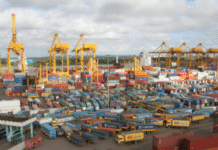
Myanmar’s deepening political crisis and India’s grave coronavirus situation are prompting international retailers and brands to divert work orders to Bangladesh because of its stability and milder-than-expected impacts of the second wave of the infections.
After a record spike in Covid-19 caseloads and deaths linked to the virus in recent months, Bangladesh is now witnessing a relatively calm situation than many other countries in the region, including India, thanks to the nationwide partial transport lockdown.
 For all latest news, follow The Daily Star’s Google News channel.
For all latest news, follow The Daily Star’s Google News channel.
And due to political stability, the country has turned into a safer place for international retailers and brands to produce goods at cheaper rates, keeping the global supply chain unaffected.
Mass protests have been taking place across Myanmar since the military seized control on February 1. Elected leader Aung San Suu Kyi and members of her National League for Democracy party are among those detained. Hundreds of people, including children, have been killed, reports the BBC.
In India, a devastating second Covid-19 wave has overwhelmed the country’s hospitals and crematoriums, and there have been widespread shortages of oxygen and medicines.
India’s total tally of coronavirus cases now stands at 25.23 million, health ministry data showed, following 263,533 new infections over the past 24 hours, while fatalities rose by a record 4,329. The official total death toll is now 278,719, Reuters reported yesterday.
One indication of work orders shifting from the neighbouring countries has become apparent in export earnings of Bangladesh between July and April of the current fiscal year.
Receipts from merchandise exports rebounded in March, rising 12.59 per cent year-on-year to $3.07 billion. This was also mainly on the back of relaxed lockdowns in the West, leading to a slow recovery in garment shipments over the preceding few months.
The recovery of export continued in April, with earnings from merchandise shipment logging a significant rebound.
Export earnings rose six times year-on-year to hit $3.13 billion in April this year, thanks to the rebound of apparel shipment after the reopening of the US and European economies.
In the 10 months to April this fiscal year, garment shipment increased by 6.24 per cent year-on-year to $26 billion, showing resilience against the Covid-19 pandemic.
Of the total earnings from the garment sector, $13.99 billion came from the export of knitwear items, which registered a 15.34 per cent year-on-year growth. Earnings from woven shipment fell 2.71 per cent to $12 billion.
“It is true that work orders are shifting to Bangladesh from Myanmar,” said a European buyer in Bangladesh, asking not to be named.
His company does not want to continue business in a country governed by a military dictator, so for the political tension and on humanitarian grounds, it was relocating orders to other countries and would continue doing so in the long run.
He could not state the exact percentage of work orders that had shifted in favour of Bangladesh. However, he said Bangladesh was receiving a major share of such contracts.
Speaking about India, the buyer said the diversion of orders to Bangladesh had been a temporary measure in response to the Covid-19 fallout as India was a major sourcing hub for his company.
The same was true for Cambodia. Some work orders had been shifted to other countries because of a lockdown in the Southeast Asian nation. But it was a temporary measure as Cambodia was also a major sourcing hub for the company.
Myanmar has become an important link in the supply chains of well-known Western brands in the luggage, fast fashion and footwear industries.
For instance, US imports from Myanmar reached $1.06 billion in the 12 months to November 30, 2020, from $245 million in 2016, according to a report on Al Jazeera.
Of the sum, apparel and footwear accounted for more than 41 per cent. Luggage imports made up nearly 30 per cent, while fish accounted for 4.4 per cent.
When asked if the coup has affected its business in Myanmar, H&M Spokesperson Ulrika Isaksson told Al Jazeera in a statement, “We expect our production in Myanmar to be affected. We are in close dialogue with our suppliers and monitoring the situation as it develops.”
The official was whether H&M plans to continue sourcing from its independent suppliers in Myanmar.
In response, Isaksson said, “While we are concerned about the situation in Myanmar and closely monitoring the developments, we refrain from taking any immediate action with regards to our presence in the country.”
Md Saiful Islam, president of the Leathergoods and Footwear Manufacturers & Exporters Association of Bangladesh, said the sector had been receiving an increasing number of work orders over the last couple of months.
“Many leather and leather goods companies have shifted orders from Myanmar to Bangladesh because of the political uncertainty,” he said.
The increase has significantly helped the recovery of Bangladesh’s leather and leather goods shipments recently.
Earnings from leather and leather goods shipment were up 8.56 per cent year-on-year to $760.92 million between July and April.
The receipts entered the positive territory after more than four years not just for the diversion of the orders from other countries but also for the clearing out of inventories and the receipts of past payments from retailers and brands, Islam said.
Faruque Hassan, president of the Bangladesh Garment Manufacturers and Exporters Association, also acknowledged that some work orders were shifting from Myanmar. However, Myanmar’s total garment export volume was too little when compared with that of Bangladesh, he said.
“The shift has had little impact on Bangladesh’s garment sector,” he said, adding that the placement of work orders in India had slowed a bit due to Covid-19.
It does not mean that Bangladesh is receiving work orders of India due to the pandemic, he said.
Export from Bangladesh in the last 15 days dipped 16 per cent compared to that last year, said former BGMEA president Rubana Huq.
The only category that has had growth is knitwear, while woven witnessed a drop of almost 6 per cent between August 20 and April 21.
“I don’t think there’s an overall recovery, but knitwear is doing slightly better,” Huq said.
Lingerie and artificial fibre-based anoraks have had a significant rise in export. Competition is still fierce, and Covid-19 has doubled the industry’s suffering, she also said.
“I think it is too early to reach any conclusion from outside,” said Zahid Hussain, a former lead economist of the World Bank’s Dhaka office.









